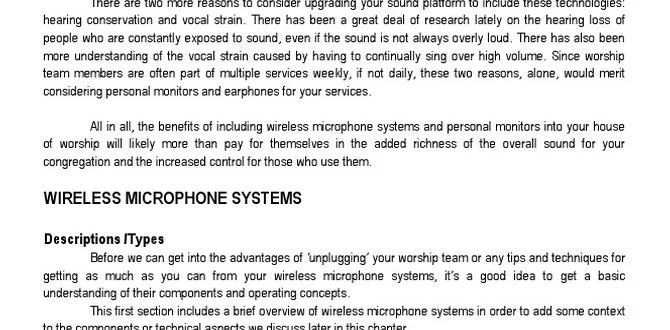Have you ever wondered how sound travels in a church? Imagine attending a service where every word is clear. That can happen with the right microphone setup for church sound.
Good sound can change everything. It makes messages powerful and music enjoyable. Without it, your favorite songs might sound flat. The right microphone setup can transform your worship experience.
Did you know that even small changes in microphone position can make a big difference? Picture this: a choir singing beautifully, yet nobody can hear them. That’s a letdown! With proper microphone placement, everyone can enjoy the performance.
In this article, we will explore how to set up microphones for your church. From choosing the right type to adjusting the settings, you’ll find tips that can easily improve your sound. Let’s dive in and make your church sound amazing!
Effective Microphone Setup For Church Sound Systems

Microphone Setup for Church Sound
Setting up microphones in a church can transform the sound experience. Did you know that the right microphone can make speakers sound clearer? Selecting the best types, like handheld or lapel mics, helps capture voices perfectly. Proper placement also matters. Place mics close to speakers for the best sound quality. Additionally, testing levels before the service ensures a smooth experience. Imagine a service where everyone hears every word clearly. That’s the power of a good microphone setup!
Understanding Different Types of Microphones
Dynamic vs. Condenser Microphones: Key Differences. Best Microphones for Vocal Performance in a Church Setting.
Microphones are like the faithful sidekicks of sound in a church. Let’s break it down: Dynamic microphones are tough cookies. They handle loud sounds well and are perfect for singing. Think of them as protection against overzealous soloists! On the other hand, condenser microphones are the divas. They catch every little sound and are great for soft singing or speech.
| Type | Best For | Durability |
|---|---|---|
| Dynamic | Loud vocals | Very Durable |
| Condenser | Soft vocals | Less Durable |
In choosing a microphone, consider your church’s needs. A good dynamic mic can make the praises ring loud and clear. But if you want every whisper to shine, a condenser is your friend. Happy singing!
Microphone Placement Techniques
Optimal Placement for Choirs and Ensembles. Positioning for Soloists and Speakers.
Finding the right place for microphones in a church can feel like playing hide and seek! For choirs and ensembles, position microphones above the singers, around 2-4 feet high. This helps capture their beautiful harmonies. Soloists and speakers need a different spot. Position their microphone close and at mouth level. This ensures their voices are clear and loud, like a trumpet! Use the table below for a quick guide:
| Group Type | Optimal Placement |
|---|---|
| Choirs/Ensembles | 2-4 feet above |
| Soloists/Speakers | At mouth level |
Audio Mixer Essentials for Church Sound
Choosing the Right Mixer for Your Setup. Basic Mixer Settings for Clear Sound.
Picking the right mixer can feel like choosing the best ice cream flavor—so many options! It’s important to find one that fits your church’s needs. Look for a mixer that has multiple channels. This lets you connect microphones and instruments easily. Make sure it has features like equalization or effects. They help create clear sound and joyful worship!
| Feature | Importance |
|---|---|
| Multiple Channels | Connect many devices |
| Equalization | Adjust sound quality |
| Effects | Add fun audio touches |
Next, you’ll want to set it correctly. Always start with the basic settings: adjust the gain for each input. Then, balance the faders. Keep the overall volume at a good level to avoid ear-splitting sounds. Remember, no one enjoys a church session that sounds like a cat sliding down a chalkboard!
Wireless Microphone Systems
Benefits and Drawbacks of Wireless Microphones. Best Practices for Using Wireless Systems in a Church.
Wireless microphones can be a game-changer for church sound systems! They provide freedom of movement and are less tangled than wired options. However, they do have some hiccups, like battery life and potential interference. To make the most of a wireless setup, place the receiver away from walls and check for channels that won’t compete with other devices. Remember, a clear voice can be heavenly, but a dropout might make the sermon feel like a comedy show!
| Benefits | Drawbacks |
|---|---|
| Freedom of movement | Battery life issues |
| No cords to trip over | Potential interference |
| Easy setup | More expensive |
Setting Up In-Ear Monitors vs. Speakers
Advantages of InEar Monitors for Performers. Balancing Stage Sound with Audience Experience.
In-ear monitors offer musicians a fantastic way to hear themselves clearly without disrupting the audience. They fit snugly in the ear, blocking out unwanted noise, which can sound like a stampede of elephants during a concert! This helps performers focus on their music. However, balancing this with what the audience hears is crucial. If performers can’t hear each other, chaos can ensue. So, both inears and speakers work hand in hand, keeping everyone happy.
| Pros of In-Ear Monitors | Pros of Speakers |
|---|---|
| Clear audio for performers | Good for audience sound |
| Blocks outside noise | Fills the room with sound |
| Can prevent ear fatigue | Can create an immersive experience |
Common Challenges and Solutions
Managing Feedback Issues in Live Sound. Troubleshooting Connectivity Problems.
Managing sound is tricky, especially in a church. Feedback can be annoying. To avoid it, position microphones away from speakers and use sound shields. If issues arise, check cables. Sometimes connections fail. Here are some tips:
- Keep speakers and mics apart.
- Use a sound mixer to adjust levels.
- Ensure all cables are securely connected.
These simple changes can improve sound quality during services. Clear sound helps everyone focus on the message.
How to fix feedback issues?
To fix feedback, move the microphone away from the speakers and adjust sound levels.
What to do if there are connectivity problems?
If you face connectivity issues, check all cable connections and replace any faulty wires.
Testing and Optimizing Your Setup
PreService Sound Checks: What to Include. Adjusting Levels for Different Services or Events.
Every good sound needs a solid start. Before the church service, take a moment for PreService Sound Checks. Check the microphones and speakers to make sure they are working right. No one wants to hear a scratchy voice or a sudden echo. Plus, it’s a great way to catch any issues early, like a sneeze hidden in the sound system!
Adjusting sound levels can make or break different services. For quieter events, lower the volume. For lively celebrations, crank it up! Everyone loves to rock out, but not when the speakers are louder than a marching band!
| Event | Sound Level |
|---|---|
| Quiet Prayer | Low |
| Regular Service | Medium |
| Celebration Event | High |
Remember, good sound is like a good stew; too much of one thing can ruin the flavor! So, test often and adjust like a pro!
Maintenance and Upgrades for Longevity
Routine Maintenance Tips for Microphones and Equipment. When to Upgrade Your Sound System for Improved Performance.
Keeping your microphones and sound equipment in top shape can feel like a game of hide-and-seek, but it’s important! Regularly check your gear for dust and grime, and give them a good clean. Look out for any strange sounds because, trust me, those whispers could be a sign your mic needs help. Upgrade your system every five to seven years for the best performance. New tech can make you sound like a superstar!
| Routine Maintenance Tips | Upgrade Signs |
|---|---|
| Clean microphones weekly. | Sound quality drops. |
| Check cables for wear. | Equipment is outdated. |
| Store items properly. | New tech trends. |
Conclusion
In summary, a good microphone setup for church sound enhances clarity and connection. Choose the right type of microphone for your space, position it correctly, and test sound levels. Always consider your audience’s needs. By following these steps, you can improve your church’s audio experience. For more tips, explore additional resources or ask an expert for advice!
FAQs
Sure! Here Are Five Questions Related To Microphone Setup For Church Sound:
Sure! Here are five questions you might ask about setting up microphones for church sound. 1. What type of microphone is best for singing? – A good choice is a handheld microphone. It helps you control your voice better. 2. How do we place the microphones? – We should place them close to the singers or speakers. This helps capture their voices clearly. 3. What should we do to reduce loud noises? – You can use microphone stands and keep the mics away from loud speakers. This helps avoid feedback sounds. 4. How do we test the sound? – We should listen while someone speaks or sings. Adjust the volume until it sounds good. 5. Why is a quiet room important? – A quiet room helps you hear the voices more clearly. This makes the sound better for everyone.
Sure! Please provide the question you would like me to answer.
What Types Of Microphones Are Most Suitable For Different Church Environments (E.G., Large Sanctuaries, Small Meeting Rooms)?
For a large sanctuary, you can use handheld microphones or wireless microphones. Handheld mics help you move around easily. In small meeting rooms, clip-on microphones are great. They are small and let you speak without holding anything. Choose the right mic based on your space!
How Can We Effectively Position Microphones To Minimize Background Noise And Feedback During Worship Services?
To reduce background noise and feedback during worship, place microphones close to the speaker’s mouth. Don’t point them at loud sound sources, like speakers or instruments. We can also use windshields on the mics to block extra noise. Make sure to test the sound before the service starts. This way, we help everyone hear clearly!
What Are The Best Practices For Setting Up Wireless Microphones For A Choir Or Worship Leaders In A Church Setting?
To set up wireless microphones for a choir or worship leaders, you should pick a quiet spot for the microphone receiver. Make sure you test each microphone before using it. Adjust the volume so everyone can hear well but not too loud. Keep the microphones away from noisy things like speakers. Finally, remind everyone to stay close to their microphones when they sing or talk.
How Can We Ensure That Our Microphone Setup Accommodates Both Spoken Word And Music, Providing Clear Sound For All Attendees?
To make sure everyone hears clearly, we should use good microphones designed for both talking and music. We can test the sound before the event to fix any issues. It helps to adjust the volume for different sounds. Placing microphones close to the speakers also makes a big difference. Finally, we should listen to feedback from attendees to improve the setup.
What Considerations Should Be Taken Into Account For Integrating Microphones With The Church’S Sound System And Mixing Console?
When we connect microphones to the church’s sound system, we need to think about a few things. First, we want to make sure the microphones work well with the mixing console, which is like a special control panel. Next, we should place the microphones where people can hear them clearly. We also have to check if we need special wires to connect everything safely. Lastly, it’s important to test the sound before the service starts.







